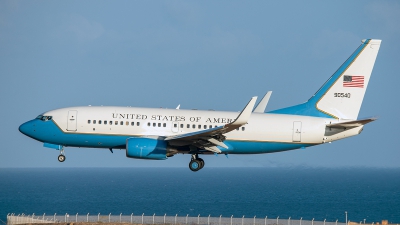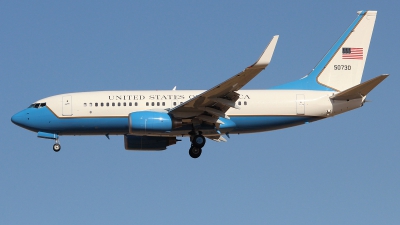Boeing C-40C (737-7CP BBJ) Aircraft Data
The Boeing C-40 is based on Boeing's next-generation 737-700C civil aircraft. The first flight of the aircraft took place in April 2000. The first of the C-40A aircraft entered service with the United States Naval Reserve Fleet Support Squadron in April 2001. The ninth was delivered in June 2006. The US Navy placed an order for two additional aircraft in December 2008, for delivery by February 2011. The first aircraft was delivered in November 2010 and second in January 2011. The USN has a requirement for up to 20 additional aircraft.
Design
As the aircraft is based on a civil airliner design, it is suitable for deployment to civil airports or military air bases. It has an aluminium alloy fail-safe fuselage and wing structure and incorporates the strengthened wing design of the Boeing 737-800 and Boeing Business Jet (BBJ).
The undercarriage of the aircraft has been strengthened to accommodate the increased gross weight. The hydraulically retractable tricycle-type landing gear is fitted with Boeing shock absorbers and Honeywell or Goodrich brakes.
Flight deck
The two-crew flight deck of the Clipper retains the features of the glass cockpit installed in the commercial 737-700 aircraft with a Honeywell common display system and five flat panel liquid crystal display screens.
Systems include a dual flight management system and an integrated global positioning system.
C-40C Differences
The C-40C is the USAF’s counterpart to the Navy’s C-40A. Both types are certified to operate in one of 3 configurations: an all-passenger (121) configuration; an all-cargo configuration of up to 8 pallets; or a combination (“combi”) configuration that will accommodate up to 3 cargo pallets and 70 passengers. Unlike its C-40A counterpart, the C-40C has always used the common 737-700 configuration with turned-up winglets.
The C-40C is not equipped with the advanced communications capability of the C-40B. Unique to the C-40C is the capability to change its configuration to accommodate from 42 to 111 passengers. The C-40C replaced three C-22s (a militarized Boeing 727) operated by the Air National Guard and National Guard Bureau to airlift personnel. The C-40C was the first military aircraft to be acquired in this manner. The 201st Airlift Squadron, District of Columbia Air National Guard acquired two C-40C aircraft in October 2002. The Air Force Reserve 932d Airlift Wing, Scott AFB, Illinois acquired three C-40C aircraft in 2007.
Engines
Two CFM International CFM56-7B24, each rated at over 27,000 pounds, are wing mounted. The engine nacelles are of fibre-reinforced plastic and graphite-Kevlar-glass-fibre composite construction.
The aircraft has a Honeywell 131-9B auxiliary power unit with engine air start capability.
Design
As the aircraft is based on a civil airliner design, it is suitable for deployment to civil airports or military air bases. It has an aluminium alloy fail-safe fuselage and wing structure and incorporates the strengthened wing design of the Boeing 737-800 and Boeing Business Jet (BBJ).
The undercarriage of the aircraft has been strengthened to accommodate the increased gross weight. The hydraulically retractable tricycle-type landing gear is fitted with Boeing shock absorbers and Honeywell or Goodrich brakes.
Flight deck
The two-crew flight deck of the Clipper retains the features of the glass cockpit installed in the commercial 737-700 aircraft with a Honeywell common display system and five flat panel liquid crystal display screens.
Systems include a dual flight management system and an integrated global positioning system.
C-40C Differences
The C-40C is the USAF’s counterpart to the Navy’s C-40A. Both types are certified to operate in one of 3 configurations: an all-passenger (121) configuration; an all-cargo configuration of up to 8 pallets; or a combination (“combi”) configuration that will accommodate up to 3 cargo pallets and 70 passengers. Unlike its C-40A counterpart, the C-40C has always used the common 737-700 configuration with turned-up winglets.
The C-40C is not equipped with the advanced communications capability of the C-40B. Unique to the C-40C is the capability to change its configuration to accommodate from 42 to 111 passengers. The C-40C replaced three C-22s (a militarized Boeing 727) operated by the Air National Guard and National Guard Bureau to airlift personnel. The C-40C was the first military aircraft to be acquired in this manner. The 201st Airlift Squadron, District of Columbia Air National Guard acquired two C-40C aircraft in October 2002. The Air Force Reserve 932d Airlift Wing, Scott AFB, Illinois acquired three C-40C aircraft in 2007.
Engines
Two CFM International CFM56-7B24, each rated at over 27,000 pounds, are wing mounted. The engine nacelles are of fibre-reinforced plastic and graphite-Kevlar-glass-fibre composite construction.
The aircraft has a Honeywell 131-9B auxiliary power unit with engine air start capability.
- Country of Origin: United States
- First Flight: 2002
- Initial Service Date: 2002
- No. Built: 7
- No. In Service: 7
- No. of Hardpoints: 0
- Crew: 6
Power:
2 × CFM International CFM56-7B turbofans, each at 121 kN
Weapons:
None
Dimensions:
| Length: | 33.63 m. |
| Wing Span: | 34.32 m. |
| Height: | 12.55 m. |
| Empty Weight: | 57,153 kg. |
| Max. Weight: | 60,781 kg. |
| Max. Payload: | 18,144 kg. |
Performance:
| Max. Speed: | 990 kph |
| Service Ceiling: | 12,500 m. |
| Normal Range: | 4,500 km |
| Max. Range: | 7,200 km |

 Random great photos of the Boeing C-40C (737-7CP BBJ):
Random great photos of the Boeing C-40C (737-7CP BBJ):





